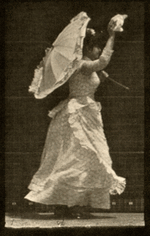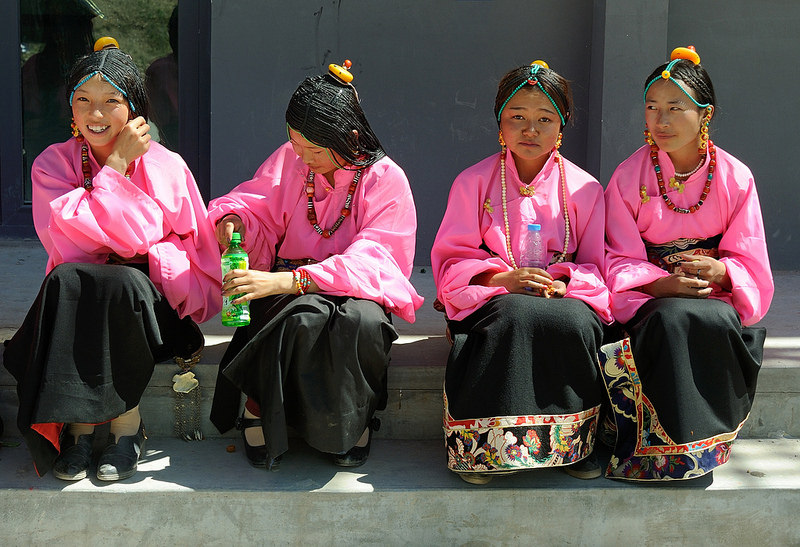-
-
Par Dona Rodrigue le 14 Décembre 2014 à 13:49
Photographie de Jan Reurink reurinkjan
Photographe Chinois, passionné par le TIBET - Merci Jan
- Photo prise le : 28 juillet 2014.
- Qumong, Sichuan, Chine
- Nikon D3

NEW GENERATION TIBETAN
Sershul Tekchen Dargyeling སེར་ཤུལ་ ཏེཀ་ ཆེན་ དར་ གྱེ་ གླིང་ is an important monastery of the Gelukpa School, located 20 km west of Deongma, on the right side of the road. This is currently the largest monastery in Sershul county, with 1200-1300 monks divided into six colleges, under the guidance of the youthful but charismatic Drukpa Rinpoche. The rain retreat festival held in August is a magnificent spectacle, attracting nomad communities.
The hills and grasslands around the monastery are sparse and spacious. The complex was founded as a branch of Chunkor but soon outgrew the latter. The recently restored buildings at Sershul, which are all near the motor road, include the Tsokchen (assembly hall), the Jamkhang (Maitreya temple), the Gonkhang (protector temple), the Dewachen Lhakhang (Amitabha temple), the Mentsikhang (where Mipham Rinpoche`s tradition is maintained), the college, a Mani Wheel chapel (containing three wheels constructed by the father of the present Drukpa Rinpoche) and a small guesthouse. A new Tsongkhapa Lhakhang, resembling a giant cathedral, has been constructed below the main complex, and was due for completion and consecration on 12 December, 2008.

Founding (1349) > Geluk > Kadam (1349 - 1599)
བྱ་ཁྱུང་དགོན་ཐེག་ཆེན་ཡོན་ཏན་དར་རྒྱས་གླིང་།
> Jakhyung Gön Tekchen Yönten Dargyé Ling
> bya khyung dgon theg chen yon tan dar rgyas gling
places.kmaps.virginia.edu/features/22670The monastery of Jakhyung Shedrubling lies on a ridge overlooking the River Ma Chu (Yellow river). This is one of the most historic and renowned Gelukpa monasteries of Amdo, founded in 1349 by Lama Dondrub Rinchen, the teacher of Tsongkhapa. The attractive monastery is situated in a small forest zone.

A local small horse festivity, along the so called highway going north east, just 40 km outsite the city of Litang. Some brave and daring man and boys showing off their horseman skills. This pleasant encounter was in the county of Nyachuka.
Local festivals are part of nomadic traditions. Horseback riding competitions, Tibetan nomads are true masters in riding
-
Par Dona Rodrigue le 14 Décembre 2014 à 13:08
PHOTOGRAPHIES de Jan Reurink reurinkjan Photographe CHINOIS fantastique

Litang county occupies the high Puborgang range, which forms a watershed between the Dri chu འབྲི་ཆུ་ (Yangtze) around Batang and the lower Nyag chu ཉག་ཆུ་ (Yalong) basin. The town of Litang, characterized by its large stone houses, lies near the source of the Li chu tributary of the Nyag chu ཉག་ཆུ་ (Yalong), and is one of the highest settlements in East Tibet at 4.014 m.


Shot to the entrance of Jinlong Gonpa (insecure of monastery name)
Present-day Dardo county broadly corresponds to the heart of the ancient Chakla Kingdom, which until the mid-20th century was governed by the Chakla Gyelpo from Dartsedo town. It therefore includes both the Minyak hinterland of the Tibetan plateau and the plunging gorge formed by the Gyeto chu and Yakra chu tributaries of the Gyarong.
The administrative capital is at Dartsedo,





Tibetan nomads herd yaks, sheep and horses. Herding the livestock is done mostly by men and older children. In the summer, the yaks are milked before they are taken to be grazed and again when they come in for the night. Each nomad family has specific areas designated by the government where they can graze their animals. The government also regulates when and where they move. They move 2 or 3 times per year. Most nomads now are only semi-nomadic.
They live in their yak wool tents for 6 to 8 months each year and live in small mud-brick homes the rest of the year. Nomad children are now required to go to school for at least 9 years. These nomad students usually live in boarding schools which are often quite far from where their families live. Nomad numbers continue to decrease each year as more and more of them are being resettled into villages and towns.


NEW GENERATION TIBETAN
Sershul Tekchen Dargyeling སེར་ཤུལ་ ཏེཀ་ ཆེན་ དར་ གྱེ་ གླིང་ is an important monastery of the Gelukpa School, located 20 km west of Deongma, on the right side of the road. This is currently the largest monastery in Sershul county, with 1200-1300 monks divided into six colleges, under the guidance of the youthful but charismatic Drukpa Rinpoche. The rain retreat festival held in August is a magnificent spectacle, attracting nomad communities.
The hills and grasslands around the monastery are sparse and spacious. The complex was founded as a branch of Chunkor but soon outgrew the latter. The recently restored buildings at Sershul, which are all near the motor road, include the Tsokchen (assembly hall), the Jamkhang (Maitreya temple), the Gonkhang (protector temple), the Dewachen Lhakhang (Amitabha temple), the Mentsikhang (where Mipham Rinpoche`s tradition is maintained), the college, a Mani Wheel chapel (containing three wheels constructed by the father of the present Drukpa Rinpoche) and a small guesthouse. A new Tsongkhapa Lhakhang, resembling a giant cathedral, has been constructed below the main complex, and was due for completion and consecration on 12 December, 2008.
-
-
-
-
-
Par Dona Rodrigue le 31 Août 2014 à 09:19

With an average elevation of more than 12,000 feet, Tibet is the highest country on earth, and is appropriately termed the “Roof of the World.” The planet’s highest mountain range, the Himalayas, soars into the Tibetan sky above rushing rivers, beautiful lakes, and high plains.
Intrepid travelers discover the beauty of Tibet on foot, by raft, and over dramatic, high-altitude roads. Treks through lower passes and foothills of the Himalayas and Karakoram make for a memorable adventure, and the hardiest hikers can even trek to the Mt. Everest base cam

p, where mountaineers launch assaults on the world’s highest summit.

Yet the natural wonders are only one aspect of this fascinating land.

Tibet’s rich cultural and religious heritage awaits the curious visitor, with visits to ancient monasteries and a host of other opportunities to learn about the Tibetan Buddhist tradition.
Travelers often begin their exploration of the country not long after arrival in Lhasa, where the 1000-room Potala Palace is built on a cliff within the city.
Itineraries
Tibet Explorer
-
-
Par Dona Rodrigue le 31 Août 2014 à 07:37

The main attraction in Tsigortang county is Drakar Tredzong Monastery. The "White Monkey Fortress" is one of the most famous monasteries in Amdo and brings many pilgrims each year. The monastery currently has around 400 monks, though in the past it has had close to 1000. Located at the base of a 5000m/ 16,400 ft. mountain, Drakar Tredzong has one of the few evergreen forests on the northern Tibetan Plateau. Wildlife such as wolves, deer, foxes, gazelle and a large variety of birds all live above the monastery. There is a pilgrimage kora winding around the mountain that takes 5 or 6 hours to complete. The mountains above the monastery offer abundant hiking routes and have excellent views of the area.
The Tsigortang area is very poor. There is a simple Tibetan style hotel located near Drakar Tredzong Monastery and some slightly better accommodations in the county town. Even though this area is poor, if you are interested in a remote Tibetan adventure, this area will not disappoint you.
kekexili.typepad.com/life_on_the_tibetan_plate/2009/03/xi...
Founding (1820-1911 (probable)) >བྲག་དཀར་སྤྲེལ་རྫོང་ཐོས་བསམ་ཡོན་ཏན་དར་རྒྱས་གླིང་།
> Drakkar Treldzong Tösam Yönten Dargyé Ling
> brag dkar sprel rdzong thos bsam yon tan dar rgyas gling
Read more: places.thlib.org/features/iframe/22977#ixzz1nOhlilesSOURCES
Jan Reurink

On the vast Peltang plain some 20 km south of Jyekundo town also called Yushu, surrounded with high peaking mountains, there was a Tibetan Horse race festival.

Jyekundo region in the northwest region of Kham , known locally as Gawa ག་ ཝ་,..The county capital is located at Jyekundo, which has a newly opened airport, Area: 13,784 sq km.

A mantra being carved into a cliff near Hor.
On Facebook at www.facebook.com/RemoteAsiaPhoto.
More on my website www.remoteasiaphoto.com.
sources Nick MAYO

Tibetan Family picnics in front of Sershul monastery, Tibet 2014
Food & Drink
Tibet’s high altitude means that it is difficult to grow many crops there. Barley is the most important and common crop and forms the basis of many Tibetan foods. Every day, many Tibetans eat tsampa, which is a dough made from barley flour. Other popular foods include wheat flour, yak meat, mutton, pork, butter, milk, and cheese. From barley flour Tibetans also make momos, which are small delicious dumplings filled with meat or vegetables.Mustard seed is also cultivated in Tibet, and therefore makes an appearance in many recipes.
Butter tea and barley beer (chang) are popular drinks in Tibet. For butter tea, the tea leaves are boiled in water, then strained and poured into a churn, where salt and butter are added. The tea has a thick buttery surface and a unique taste. Chang is thick and white and has a sweet and strong taste. Just like our beer, it is quite alcoholic, so for adults only!
The sacred Mountain Zhara Lhatse 5820m and the Jinlong Gonpa, Tibet 2014
High peaking above the graslands is the snow-covered peak of Mt Zhara Lhatse with a unique sharp pointed shape of 5820m hight.
This mountain is also strongly connected with the stories of Guru Rinpoche (Padmasambhava).
The Mountain Zhara Lhatse is located in Tawu county, while the village Lhagang is located in Dardo county from where this picture is taken.
Lhagang is surrounded by five holy mountains : Chenresig, Jambayang, Chana Dorje and Drolma, and to the north, the snow mountain called Zhara.
Because it is surrounded by these holy mountains, it is a special and blessed place.sources
reurinkjan

Motorbike for the whole family, Tibet There was an important lama visiting for some days in the Sershul monastery, so every Tibetan was dressed at it best and yes even the motorcycle was clean to shine. Tibetans came in big numbers, and in their best costumes. It was a great treat for photographers.

 Suivre le flux RSS des articles de cette rubrique
Suivre le flux RSS des articles de cette rubrique
Dona Rodrigue






















